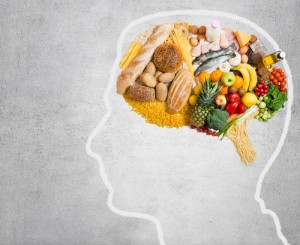The subconscious in our diets
In our subconscious there are beliefs about food that are rooted in our childhood, which we acquired through the following:
* what our parents, teachers and doctors told us about food;
* what we ate as children;
* what we saw our parents and immediate family eating;
* what we saw people around us such as friends and classmates eating;
* ideas that the media (mainly TV ads) managed to penetrate into our subconscious;
* our experience about how our body reacts to certain foods (allergies, intolerances);
* ideas that our religion has about food;
What is more, the smell of food goes directly to the subconscious part of our brains, so the sense of taste affects our instinctive decisions.
The subconscious is also responsible for many decisions we take about our food without thinking, for example:
* how we eat: the speed at which we eat, the speed at which we chew and swallow;
* the number of courses, the amount of food;
* the amount of water or other beverages we drink during meals (and during the day);
* what we do while we eat: watch TV, talk;
* if we sit quietly during the meal or get up to collect the plates after each course; if we prepare all the food we put on the table beforehand or we keep bringing things as we eat;
* even what we buy!
* and there is an endless list of other habits!
Regarding the things we buy, I would like to add that most decisions we make in the supermarket are automatic. Most people basically buy the same things during many years. We also buy things impulsively and it is for this reason that placement strategies for certain products and advertising work so well! Ads, which are repetitive ideas, are anchored in our subconscious.
As a nutritionist, it is interesting to see that 90% of a person’s breakfast and lunch is the same every day! For example someone’s breakfast consists of coffee and croissant every day, changing only the type of croissant; for someone else it is orange juice and cereals with milk, only changing the type of juice or cereals; for another person it is a yogurt with muesli and tea, and only the type of tea or the type of yogurt changes.
Conscious-subconscious conflict
Some typical myths, such as the fact that we must drink milk because it is good for our bones, are deeply rooted in our subconscious since our childhood.When we come to understand consciously that these myths are not true, a conflict is created between our conscious and subconscious beliefs, which does not help in any way our physical and mental health.
Given this conflict, there are three solutions:
1) going back in our conscious thoughts
2) trying to change the subconscious so that it can go to the same direction as our conscious
3) reducing the impact of the subconscious
The first solution is impossible, because once our reason has been convinced about what is right, it is difficult to convince it that a misconception is correct. So the second option, changing the subconscious is a better one.
The third option is what is nowadays known as mindfulness.
How to change the subconscious
The ideas and thoughts of the subconscious can be changed when a fact (idea or action) is repeated several times. Consciously repeating a fact, it finally gets anchored in the subconscious. This is how we all learn the multiplication tables, cycling, driving, or singing songs.

But our conscious has to dominate our mind in order to repeat this kind of idea or action so many times, for which a strong willpower is needed, which is not always easy.
Another easier way is mentally imagining several times that this new action is performed so that it can be incorporated into the subconscious, using meditation and/or visualisation. There are many therapies that propose a more direct and easier way to "reprogram" or change the subconscious, among which we can highlight hypnosis, PSYCH-K and EFT.
Mindfulness
 Mindfulness suggests that our actions and decisions are made consciously, consequently we should try to avoid reacting impulsively and irrationally. It is about controlling our minds so that they follow the wishes of the conscious.
Mindfulness suggests that our actions and decisions are made consciously, consequently we should try to avoid reacting impulsively and irrationally. It is about controlling our minds so that they follow the wishes of the conscious.The control of our behavior will substantially improve practicing mindful meditation or praying, however, only to a limited extent, as people act instinctively by nature 95% of the time, so it's not easy to reduce this percentage.
Conscious eating
Below I will explain some indications on how to practice mindfulness when eating. The intention is to eat healthily and resist impulses created by the subconscious to eat sugars, alcohol, chocolate, etc.Eating consciously means being present, making decisions rationally. It means making the right choices before eating, and thinking about what we are eating instead of our worries, arguments, the news, etc. It also means listening to the body in order to identify what it really needs.
To begin with, it is necessary to relax before eating: we should disconnect from our environment such as from work, news on TV, the phone, friends, colleagues or family. Start eating alone during some days, in an almost meditative state that is called conscious eating. In order to achieve this you should do the following:
1. – Do some breathing exercises before eating in order to relax. You could even do some meditation.
2. – Focus on the sensations of your body before, during and after meals. Ask yourself the following questions:
* Am I really hungry? Analyse whether the stomach is moving and making "noises" indicating that it is hungry, or if you are going to eat because it is time to.
* What am I hungry for? What food do I crave to eat? Maybe only a salad or a meat or rice dish? Is my body really asking for it or are my preconceptions telling me to eat that?
3. – Once you have identified what your body really needs, you can start preparing it. To prepare most healthy dishes you don’t need to spend much time in the kitchen. You can always have some previously prepared rice or a vegetables in the fridge, which is possible to be kept for two or three days. You can prepare a salad, vegetables, meat, fish or eggs fairly quickly even when you don’t have much time available.
4. – Cooking your own food opens the senses and helps to stimulate the digestive system. Moreover, if made consciously, and prepared with love, having positive thoughts in the meantime, vitamin L (love) is also added to food.
5. – If you believe in any religion or simply in the power of your mind, giving thanks for the food you are going to eat and blessing it increases the positive energy or the vitamin L of the meal even more.
 6. – Eat consciously: taste the food, focus on the smell, texture, presentation (color, shape), taste and temperature. Chew slowly.
6. – Eat consciously: taste the food, focus on the smell, texture, presentation (color, shape), taste and temperature. Chew slowly.7. – Be aware so that you can notice when you are full and stop eating at that moment. If there is still some food on the plate, you can just store it in the fridge, there is no need to eat up everything.
8. – Again, you should give thanks for the food you have eaten. Visualize how food is digested properly to its elemental parts (for exaple, imagine some scissors that are cutting food up to elementary substances), and how these are then distributed throughout the body transported by the blood to feed all the cells of your body.
9. – After eating, pay attention to the reactions of your body: are you starting to have gases, pain or noise in the belly, or is there a sensation of satisfaction and renewed energy? Be aware of all the possible symptoms (pain anywhere in the body, immune reactions, heart, etc.), both immediately after eating and a few hours later. In case any symptoms occur at any point, write down everything that you have eaten in the past 48 hours.
You should perform this exercise for some time until you are able to eat consciously without much concentration, being accompanied by others.
 Some ideas were mentioned in a
Some ideas were mentioned in a 











